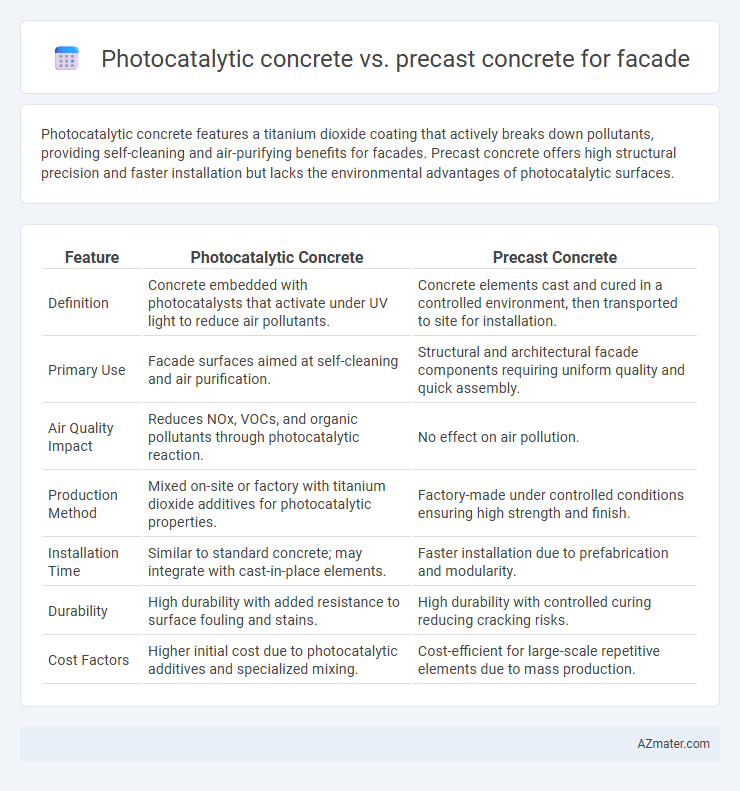Photocatalytic concrete features a titanium dioxide coating that actively breaks down pollutants, providing self-cleaning and air-purifying benefits for facades. Precast concrete offers high structural precision and faster installation but lacks the environmental advantages of photocatalytic surfaces.
Table of Comparison
| Feature | Photocatalytic Concrete | Precast Concrete |
|---|---|---|
| Definition | Concrete embedded with photocatalysts that activate under UV light to reduce air pollutants. | Concrete elements cast and cured in a controlled environment, then transported to site for installation. |
| Primary Use | Facade surfaces aimed at self-cleaning and air purification. | Structural and architectural facade components requiring uniform quality and quick assembly. |
| Air Quality Impact | Reduces NOx, VOCs, and organic pollutants through photocatalytic reaction. | No effect on air pollution. |
| Production Method | Mixed on-site or factory with titanium dioxide additives for photocatalytic properties. | Factory-made under controlled conditions ensuring high strength and finish. |
| Installation Time | Similar to standard concrete; may integrate with cast-in-place elements. | Faster installation due to prefabrication and modularity. |
| Durability | High durability with added resistance to surface fouling and stains. | High durability with controlled curing reducing cracking risks. |
| Cost Factors | Higher initial cost due to photocatalytic additives and specialized mixing. | Cost-efficient for large-scale repetitive elements due to mass production. |
Introduction to Photocatalytic and Precast Concrete
Photocatalytic concrete incorporates titanium dioxide as a catalyst to reduce air pollutants by breaking down organic compounds and nitrogen oxides when exposed to sunlight, enhancing environmental sustainability for building facades. Precast concrete involves casting concrete elements in a controlled factory environment, allowing for high precision, durability, and faster installation on construction sites. The choice between photocatalytic and precast concrete for facades depends on the desired balance between environmental benefits and structural efficiency.
Key Differences in Material Composition
Photocatalytic concrete incorporates titanium dioxide nanoparticles, enabling it to break down pollutants and self-clean through photocatalysis, unlike precast concrete which relies on traditional cementitious materials without such photocatalytic additives. The presence of titanium dioxide in photocatalytic concrete contributes to enhanced air purification and reduced surface dirt accumulation, while precast concrete prioritizes ease of manufacturing and structural consistency. Material composition in photocatalytic concrete is optimized for environmental sustainability, whereas precast concrete focuses on modular production and installation efficiency.
Photocatalytic Concrete: How It Works
Photocatalytic concrete incorporates titanium dioxide (TiO2) nanoparticles that activate under UV light to break down pollutants such as nitrogen oxides (NOx) and volatile organic compounds (VOCs), leading to cleaner air around the facade. This self-cleaning mechanism accelerates the oxidation of organic dirt and airborne contaminants, reducing maintenance frequency compared to traditional precast concrete. The continuous photocatalytic reaction helps preserve the facade's appearance and contributes to sustainable urban environments by improving air quality.
Precast Concrete: Features and Advantages
Precast concrete for facades offers precise manufacturing control, ensuring consistent quality, dimensional accuracy, and faster installation times on site. Its modular nature allows for complex architectural designs, enhanced durability, and superior resistance to weathering, providing long-term structural performance. Precast concrete also provides excellent thermal insulation and soundproofing properties, reducing energy consumption and improving occupant comfort.
Environmental Impact and Sustainability Comparison
Photocatalytic concrete contains titanium dioxide which actively breaks down pollutants, reducing urban air pollution and improving environmental quality over time. Precast concrete offers sustainable benefits through controlled factory production, minimizing waste and enabling efficient resource use, yet it lacks the active pollution-reducing properties of photocatalytic variants. Evaluating facade applications, photocatalytic concrete contributes to long-term air purification and self-cleaning effects, whereas precast concrete prioritizes durability and resource efficiency with lower embodied carbon during manufacturing.
Aesthetic Options and Architectural Flexibility
Photocatalytic concrete offers superior aesthetic options by maintaining cleaner surfaces through its self-cleaning properties, which help resist pollution and reduce maintenance efforts on facades. Precast concrete provides greater architectural flexibility with customizable shapes, sizes, and textures, enabling intricate designs and faster installation processes for diverse facade applications. Combining photocatalytic coatings with precast elements can maximize both visual appeal and long-term durability in modern architectural projects.
Durability and Maintenance Requirements
Photocatalytic concrete enhances facade durability by actively breaking down pollutants and reducing surface deterioration, leading to self-cleaning properties that minimize maintenance frequency. Precast concrete offers superior structural consistency and controlled curing, resulting in high durability but typically requires regular cleaning and protective coatings to manage weather-related wear. The choice between photocatalytic and precast concrete for facades hinges on balancing long-term maintenance savings with initial material performance under environmental exposure.
Cost Implications and Economic Feasibility
Photocatalytic concrete for facades generally incurs higher initial costs due to advanced material components like titanium dioxide, which enhances air purification but raises production expenses compared to standard precast concrete. Precast concrete offers economic feasibility through mass production, shorter installation times, and reduced labor costs, making it a cost-effective choice for large-scale projects. Long-term maintenance savings with photocatalytic concrete may offset upfront costs by reducing pollution-related facade cleaning and deterioration, but budget constraints often prioritize the lower initial investment of precast options.
Installation Processes and Construction Timelines
Photocatalytic concrete offers a self-cleaning surface that reduces maintenance requirements but requires careful handling during installation to preserve its photocatalytic properties, often extending the initial curing process. Precast concrete facade panels allow for faster installation on-site due to off-site manufacturing and standardized sizing, significantly shortening overall construction timelines. While photocatalytic concrete can integrate into precast panels, balancing the benefits of pollution reduction with installation efficiency is key for project planning.
Best Applications for Photocatalytic vs. Precast Concrete Façades
Photocatalytic concrete is ideal for urban facades requiring pollution reduction and self-cleaning properties due to its titanium dioxide content, which breaks down airborne pollutants and organic matter. Precast concrete offers superior structural flexibility, faster installation, and high durability, making it suitable for large-scale projects needing uniform aesthetics and rapid construction timelines. Combining photocatalytic concrete with precast techniques enhances facades by providing both environmental benefits and efficient building methods in complex architectural designs.

Infographic: Photocatalytic concrete vs Precast concrete for Façade
 azmater.com
azmater.com